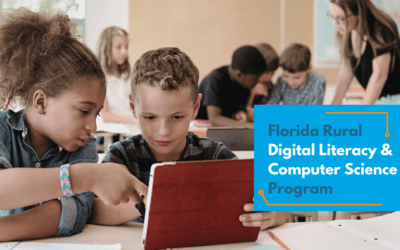As the digital landscape continues to evolve at a rapid pace, educators, parents and policymakers are increasingly focused on preparing students for the workforce of tomorrow. While basic digital literacy, coding and online safety are key parts of most K-12 digital skills curriculum, there are lesser-known skills that are equally important for students to thrive in a technology-driven world.
The Current State of Digital Literacy Curriculum
Today’s digital literacy curriculum in many educational systems primarily focuses on foundational skills such as basic computer use, internet navigation, online safety and the fundamentals of digital communication. While these are essential building blocks, most educators still emphasize traditional literacy skills over the more nuanced aspects of digital fluency, like data analysis, media literacy, or cybersecurity. Schools often introduce students to basic programming and office suite tools but leave out critical topics such as evaluating digital sources, managing online privacy and understanding digital rights. This gap means that many students are not fully prepared to navigate the complexities of a digital-first world, especially as the workforce demands more advanced technology-related competencies.
However, the future of digital literacy education is heading toward a more holistic approach that integrates advanced skills with traditional digital competencies. As technology becomes increasingly ingrained in all career paths, schools are beginning to recognize the importance of teaching students how to solve problems using digital tools, collaborate effectively in virtual environments and critically assess the digital content they encounter. Curriculum is gradually expanding to include areas such as digital ethics, cybersecurity awareness, data literacy and artificial intelligence, preparing students not just to be consumers of technology but to be innovative creators and informed citizens in an increasingly tech-driven society. This shift represents a broader recognition that digital literacy is about much more than knowing how to use devices—it’s about fostering a deeper understanding of technology’s role in shaping our world.
Key Overlooked Digital Skills for Student Success in the Modern Workforce
In addition to foundational digital literacy skills like basic computer use and internet navigation, there are several overlooked digital competencies that are essential for student success in today’s rapidly evolving workforce. As technology continues to drive innovation and reshape industries, mastering these skills can give students a competitive edge. From understanding data and cybersecurity to navigating virtual collaboration and digital project management, these often-overlooked skills are crucial for preparing students to thrive in the digital age and meet the demands of modern careers.
1. Data Literacy: Navigating the World of Information
In today’s data-driven world, the ability to understand, interpret and work with data is crucial. Data literacy goes beyond knowing how to collect data; it involves analyzing trends, drawing meaningful insights and making informed decisions based on evidence. Many students are exposed to data through basic statistical methods, but they are not taught how to process large datasets, visualize data effectively, or critically assess the reliability of sources.
Teaching students how to navigate, interpret and present data is vital for their future careers. In fields ranging from marketing and finance to healthcare and public policy, data-driven decision-making has become an important part of operations in the workforce. Data literacy enables students to sift through information, detect biases and provide evidence-based solutions. Familiarity with tools such as Microsoft Excel, Google Sheets, Tableau or Python for data analysis can give students a competitive edge.
2. Digital Problem-Solving: Thinking Critically with Technology
Digital problem-solving is another essential skill often overlooked in K-12 curriculum. Many students are taught to solve math problems or conduct scientific experiments, but they are rarely asked to use technology to address real-world problems creatively. This form of critical thinking in a digital environment is invaluable for innovation.
For workforce-readiness, students must learn how to leverage technology as a problem-solving tool, whether through building algorithms, developing apps, or using digital tools to streamline complex processes. Digital problem-solving includes learning how to assess a technological problem, selecting the right tools and iterating solutions until the optimal outcome is achieved. Engaging students in digital design thinking processes and project-based learning that uses technology to solve community or global challenges can hone this skill.
3. Cybersecurity Awareness: Protecting Digital Assets
Cybersecurity is often taught from a very basic perspective—such as not sharing personal information online or using strong passwords. However, a deeper understanding of cybersecurity is crucial in the increasingly complex online world, as cyber threats are growing exponentially. Students need to be aware of the evolving nature of these threats and understand how to protect not only their personal data but also their organization’s information systems.
For example, teaching students about encryption, firewalls, multi-factor authentication and how hackers exploit vulnerabilities can provide them with foundational cybersecurity awareness. As future employees, they will need to be prepared to contribute to their company’s security measures, especially as many organizations increasingly rely on remote work environments. Additionally, there are growing opportunities in cybersecurity-related careers, making this an essential area of study for students who may not have considered it as a potential path.
4. Collaboration in Virtual Environments: Mastering Remote Work Skills
Collaboration in a digital space is very different from working in a physical environment. With the shift to hybrid and remote work models, students must become proficient in virtual collaboration platforms such as Zoom, Slack, Microsoft Teams and Google Workspace. Learning how to communicate clearly, manage projects across time zones and collaborate asynchronously will be key in future workforce environments.
Students should be given opportunities to work on group projects using these tools, learning how to delegate tasks, track project progress and manage time effectively when working remotely. In addition to mastering the tools, they need to learn how to adapt their communication style to virtual settings, understanding when a video call is necessary versus when an email or message will suffice. Emotional intelligence and digital etiquette (also known as “netiquette”) also play crucial roles in virtual teamwork.
5. Media Literacy: Evaluating Digital Content
While many students are accustomed to consuming information online, they often lack the critical media literacy skills required to evaluate digital content effectively. As misinformation and disinformation spread across social media platforms, the ability to discern credible sources from unreliable ones is increasingly important.
In workforce settings, professionals need to be adept at filtering out false information and using credible data to inform decisions. Media literacy involves understanding the mechanisms of persuasion in digital media, recognizing biases and knowing how algorithms influence what content appears in social media feeds. Equipping students with these skills will not only make them smarter consumers of digital content but also help them become responsible creators of content.
6. Understanding and Navigating Digital Rights and Ethics
Digital rights and ethics are becoming more critical in the broader conversation about digital citizenship. Students need to be aware of their digital rights, such as the right to privacy, the right to be forgotten (in certain jurisdictions) and the laws surrounding intellectual property. In the digital economy, understanding these rights is crucial for navigating social media, protecting creative works and respecting others’ privacy online.
Workforce-readiness also requires a strong grounding in digital ethics. As artificial intelligence (AI) and machine learning technologies become more prevalent, employees need to consider the ethical implications of their actions. Ethical dilemmas, such as data privacy, algorithmic bias and the social impact of technology, should be included in students’ digital education. Engaging students in debates about these issues and exposing them to real-world case studies can help them develop a nuanced understanding of their current and future ethical responsibilities in a digital world.
7. Digital Project Management: Organizing Workflows and Teams
Project management is a vital workforce skill that is increasingly facilitated by digital tools. Tools such as Trello, Asana, Monday.com and Jira are widely used across industries to organize teams, manage projects and streamline workflows. Introducing students to these platforms can enhance their ability to manage tasks, collaborate with peers and track project progress effectively.
Beyond just using these tools, students should also learn how to set realistic project goals, manage timelines, allocate resources and conduct post-project assessments. This will equip them to handle complex tasks in a variety of career fields.
8. Digital Marketing and Personal Branding
While many students engage with social media regularly, few understand the strategic aspect of digital marketing and personal branding. These skills are increasingly necessary in industries that rely on a strong digital presence, such as e-commerce, entertainment and even healthcare.
Students should learn how to craft a personal brand that aligns with their career goals, using platforms like LinkedIn to showcase their skills and network with professionals. They should also be introduced to basic digital marketing concepts, such as search engine optimization (SEO), content creation, social media management and analytics. Understanding these principles can benefit them in fields ranging from marketing to entrepreneurship.
Final Thoughts
As technology continues to transform the workforce, equipping students with a broader suite of digital skills will be key to their success. From data literacy and cybersecurity awareness to digital project management and ethical considerations, these skills will enable them to navigate the digital world confidently and responsibly. By incorporating these competencies into the curriculum, educators can better prepare students for a future where digital proficiency is not just an advantage but a necessity for workforce-readiness.

Learning.com Team
Staff Writers
Founded in 1999, Learning.com provides educators with solutions to prepare their students with critical digital skills. Our web-based curriculum for grades K-12 engages students as they learn keyboarding, online safety, applied productivity tools, computational thinking, coding and more.
Further Reading
Florida Offers Digital Literacy & Computer Science Program to Rural Schools
Florida’s Lafayette County School District and Learning.com have partnered to launch the Florida Rural Digital Literacy & Computer Science...
What Does Effective Typing Software Look Like?
The importance of keyboarding instruction in elementary classrooms is well established. And with a plethora of typing software to introduce students...
The Connection Between Keyboarding and Literacy Skills
Literacy skills typically refer to the ability to read and write, and, more traditionally, refer to doing so with pen and paper. However, as more of...




